Who Is Responsible For Mold In A Rental Property?
It may be microscopic, but mold can be a monumental menace to landlords and tenants alike. The mess is bad enough, but the presence of mold in residences also has been linked to significant health issues, including serious respiratory illnesses. With rental property mold, the concerns extend beyond the tenant to the property owner or manager — and they can grow exponentially. In addition to cleanup costs, there could be lengthy lawsuits, future vacancies and a ruined reputation.
If you are a landlord or property manager, you should know that you are not always legally liable for mold issues, however. And when it comes to preventing mold, or remediation efforts if it’s already an issue, there are tenant responsibilities that accompany your own.
A Look at the Legal Side
It’s not possible to quickly summarize who is legally liable for mold in a rental property, as laws and guidelines vary greatly by location. The U.S. Environmental Protection Agency has no regulations or standards regarding airborne mold contaminants, but some states and cities have addressed mold either directly or under regulations pertaining to indoor air quality, properties being habitable, or as a legal nuisance.
Landlords and property managers should take any legal actions seriously. While most molds are harmless, some people are sensitive to them, and even the Centers for Disease Control and Prevention acknowledges that people with sensitivities can have “intense reactions” to exposure. Here’s an example, albeit extreme, of the potential fallout: A Rhode Island man recently sued a property developer for $60 million, claiming he got an incurable lung disease from unsafe mold in his apartment that he alleges the developer knew about.
In instances when the damage or injury is due solely to the tenant’s negligence, landlords are not liable. However, defending yourself in a lawsuit can be costly. Thus, it’s incumbent on you as a landlord or property manager to check with your state’s EPA, your local government and the health department to learn of any regulations or guidelines that might affect your liability. This includes determining whether there’s a disclosure law that requires you to inform tenants and would-be tenants about the presence (or even suspected presence) of mold.
Who’s Responsible for Mold Prevention?
Mold issues begin with excess moisture. Some potential sources are renter responsibilities. Tenants should:
• Keep their residences well-ventilated to prevent high humidity
• Use exhaust fans
• Vent dryers
• Wipe away any condensation
• Keep their places clean
• Report any suspected mold growth immediately
Encourage tenants to keep those things in mind from the get-go, and you could avoid a problem. Landlords, meanwhile, must tend promptly to these issues, at a bare minimum:
• Leaking roofs
• Leaking windows
• Leaking pipes
• Foundation leaks/seepage
Address these issues as soon as possible. Once materials become water-soaked — whether it’s wood, drywall or furniture — mold growth may begin in less than 48 hours.
Who Must Handle Mold Cleanup?
As with mold prevention, there are instances when tenant responsibilities indicate the tenant should clean rental property mold, and there are times when that falls upon the landlord or property manager. The cause of the mold should be the determining factor. Either way, remediation efforts should be addressed before the mold growth turns into a major problem. If mold growth already is extensive, cleanup should be left to trained professionals to prevent further contamination.
Mold is just one potential issue out of the hundreds you may deal with as a landlord or property manager. Our objective at American Apartment Owners Association is to provide an array of member benefits designed to help you navigate property management issues more efficiently.
Disclaimer: All content provided here-in is subject to AAOA’s Terms of Use.















 Accessibility
Accessibility